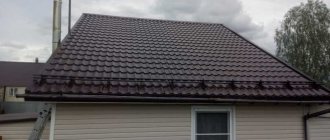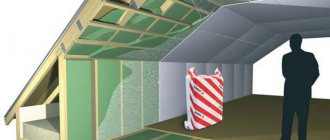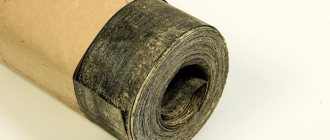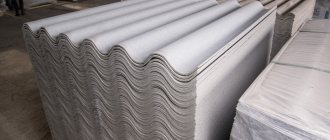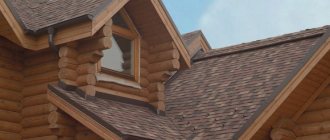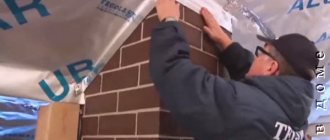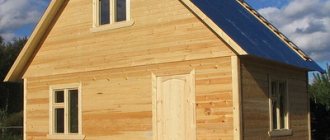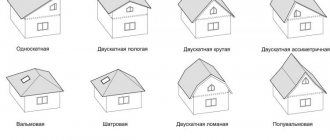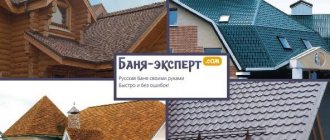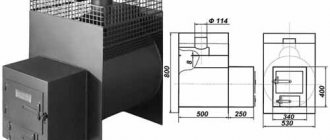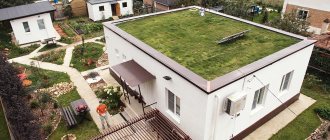Roof preparation
Insulation installation diagram.
When insulating a roof with your own hands, first of all you need to draw up a work plan and decide on thermal insulation materials. Any roof, regardless of the type of structure, consists of an external and an internal part. The roof from the outside (from the street) is called the roof, and the inside part is made up of a frame of rafters and floor slabs. In order for the roof to be warm and last a long time, before starting work, if necessary, you need to carry out repair work, get rid of moisture and all its manifestations on the roof structure: rust, mildew or mold. In this case, the metal parts are cleaned with a metal brush and coated with anti-corrosion agents, and areas affected by mold or mildew are treated with antiseptic compounds.
Regardless of the type of roof, if there is no insulation, the heat loss of the house can be 25%
Based on this, it is important to choose a suitable thermal insulation material. To simplify the installation of insulation with your own hands, the width of the slabs should correspond to the distance between the rafters
Otherwise, cold zones will form in unfilled areas, which will lead to a decrease in the quality of the insulating structure. If you use roll insulation (instead of slab insulation), you can set any width by cutting the roll with a regular wood saw. This will be relevant if the distance between the rafters is different. To keep the roof warm, today there is a wide selection of insulation materials. Each of them has its own pros and cons:
Scheme of a pitched roof with insulation.
- Glass wool is relatively cheap, easy to install, and has good thermal insulation characteristics. It must be used together with waterproofing, as it can lose up to 60% of its thermal insulation properties when wet. It is not a favorable environment for the life of rodents and insects.
- Mineral wool is similar in characteristics to glass wool, but has a long service life (up to 50 years). It is very convenient for DIY installation, as it is available in rolls or in the form of slabs.
- Basalt slabs - the main advantage of this insulation is its high fire resistance. When wet, it loses its thermal insulation properties, therefore, like other fiber insulation materials, it should be protected from moisture.
- Polystyrene foam is one of the cheapest, but no less effective insulation materials. The variety of slab sizes allows it to be used for any roof structure. The disadvantage is the fragility of the slabs, so you need to be careful during installation. In this case, the roof can become a habitat for rodents when using polystyrene foam as insulation.
- Expanded clay - the main advantage is the environmental friendliness and fire resistance of the material. At the same time, it is resistant to biological influences. But the application technology mainly applies to horizontal surfaces (roofs, ceilings), which limits its use. It is also heavier than mineral wool.
- Polyurethane foam is a liquid insulation with fairly low thermal conductivity. It is applied by spraying onto the prepared waterproofing layer. Suitable for cases where you need to quickly carry out insulation measures.
Review of insulation materials
Regardless of the type of roof in the house, if it has not been insulated, the house will lose on average up to a quarter of the heat generated.
Therefore, you need to approach the choice of thermal insulation material wisely. To simplify installation, it is better to choose slabs that correspond to the existing distance between the rafters. Otherwise, areas will form through which the cold will pass, which will significantly reduce the quality of insulation.
In the case of using roll insulation, their width must also be selected based on the distance between the rafters.
In total, you can choose insulation from a large number of options, each of which has its own positive and negative sides:
- Glass wool. This material is relatively cheap and very easy to install. It has excellent thermal insulation properties. However, glass wool should be used exclusively in conjunction with some kind of waterproofing, since if moisture gets on it, it loses most of its insulating properties.
- Mineral wool. It has almost identical properties to glass wool, but its service life is much longer and is almost 50 years.
- Basalt slabs. This material has high fire resistance. However, similarly to glass wool, it loses its properties if it gets wet.
- Styrofoam. It is one of the most affordable insulation materials, but at the same time very effective. It is produced in the form of slabs of different sizes, which makes it possible to use it for arranging almost any type of roof. The main disadvantages of this material are its fragility, as well as its susceptibility to rodents.
- Expanded clay. Its main advantages are environmental friendliness and fire resistance. In addition, this material is resistant to various biological influences. However, its use is only possible on horizontal surfaces due to its shape. At the same time, expanded clay has more weight than mineral wool.
- Polyurethane foam. It is a liquid insulation with very low thermal conductivity. It is sprayed onto previously prepared waterproofing. Indispensable for quick and easy thermal insulation. (Read about roof insulation with polyurethane foam here).
Icing on the roof
As practice shows, snow on the roof does not pose any danger, except for additional weight on the roof frame. The danger from snow appears when it begins to melt, resulting in the formation of ice.
Do-it-yourself insulation
And because of ice, icicles and ice plugs appear in drainage systems. In addition, ice has a negative impact on the quality of the roof covering. And this is not the only unpleasant moment for the roof.
The main reason for the formation of ice is the difference in air temperature between day and night. At the same time, snow melts due to heat transfer from the living space to the attic, and from there to the roof.
For this reason, a warm roof prevents all these problems. Although a lot depends on the material with which the roof is covered.
At this temperature, the air contains a small percentage of humidity, which completely eliminates the possibility of precipitation. And, if there is no precipitation, then there is nothing for ice to form from.
Types of heated roofs
Heated roofs can be divided into several types. The first on this list is the so-called cold roof. This design has fairly reliable roof insulation, and the air temperature in the attic is much higher than in the open space.
Ice forms on such structures during a thaw. In this case, there is no point in heating the roof itself, and it is enough to lay the cable only in the drainage system. The power of the heating cable does not exceed 60 W/m.
Warm roofs do not have the required thermal insulation, which leads to heating of the lower layer of snow, which turns into water.
It is this water that enters the drainage system that forms blockages and traffic jams. For this option, heating the roof edge is required. This will prevent snow from accumulating on the roof.
On pitched roofs, the heating cable is installed both on the drainage system and along the edges of the roof. There is an option to install the system in some areas of the roof and valleys. By the way, this is directly related to the question of how to make a warm roof. Because it is the correct installation of the cable that will lead to the quality of water drainage.
On flat roofs, the heating system must be placed in all pipes that are in open space. Such roofs need to be heated in two places.
The heating area in the upper part of the roof should be at least four meters, and the area in the lower part - about two meters. If there are overflows in areas of a multi-level roof, it is also necessary to install cables and also heat them. By the way, in places where there are overflows in the roof, attention is more serious. Still, this is a junction.
Roof lightning protection
When talking about roof insulation, one cannot help but touch upon such an aspect as lightning protection. No matter how durable the covering material with a super protective layer is, lightning is quite capable of burning through it. And since it is laid on a wooden sheathing, melting and burns can cause a fire. Therefore, creating protection to intercept a lightning discharge and redirect it to the ground is necessary.
Houses with a metal roof do not need to install lightning rods; for them, it is enough to provide a down conductor made of thin steel wire and its grounding
Lightning protection device
There are two types of lightning protection - internal and external. The internal one protects all electrical appliances in the house from overvoltage. The cheapest and easiest way of internal protection is to turn off electricity in the house or at least electrical appliances from energy sources during a thunderstorm. External lightning protection is designed to meet a lightning strike at the roof, conduct it along a safe path (down conductor) and neutralize it in the ground.
Internal lightning protection protects electrical appliances from overvoltage, and external protection protects the roof from lightning discharge and possible melting of the covering material
The external lightning insulation scheme is quite simple. It is easy to do it yourself using a gas apparatus and clamps for attaching the down conductor.
The lightning protection system is not a very complicated device, so you can easily and quickly do it yourself
This protection system consists of the following elements.
- Lightning rod (lightning rod) - “bait” for lightning in the form of a galvanized, copper or aluminum pin with a diameter of approximately 12 mm and a height of 0.2–1.5 m, installed at the highest point of the roof. You can replace the pin with a lightning mesh - important for flat roofs - or with a metal cable laid along the ridge ridge.
- A current conductor is a charge conductor from a lightning rod to a ground electrode, made of steel wire Ø 6 mm, descending from the roof along the walls of the building and secured with clamps or staples.
- Ground electrode is a device that ensures contact of the conductor with the ground. This can be a welded structure made of angle bars and pipes buried in the ground, a metal barrel, a sheet of iron, or steel reinforcement driven into the soil. For the ground electrode to work effectively, the soil around it must be moist. Therefore, it is recommended to periodically moisten it with water during drought, and even better, drain wastewater into this place.
Every year before the start of the rainy season, you need to inspect the lightning rod, checking all fastenings. Loose fasteners should be tightened. Once every 5 years it is necessary to open the grounding device and check it for the depth of corrosion. If rust has covered ⅓ of the ground electrode, it needs to be replaced.
Video: DIY lightning rod, budget option
In this article, we looked at the issues of roof insulation so that you can navigate the variety of materials available today to solve this problem. But you need to understand that even perfect insulation of the roof structure will not give the desired effect without suitable protection of the foundation, walls, floors and ceilings. Only a set of isolation measures will create truly comfortable living conditions in the house. Good luck to you.
Methods for insulating the attic
In order to figure out how to insulate an attic roof for winter living, you need to know that there are several insulation options: internal and external.
Insulating the roof from the outside is an ideal option, since such a structure will not let in heat from the inside due to the warm circuit and will be reliably protected from freezing. This prevents the formation of condensation, therefore, the risk of mold and mildew is minimized. However, if the attic roof is already covered with roofing material, then insulating it will be extremely difficult, and the roofing material will have to be removed.
Most often, the attic is heated for further living in it from the inside. For this purpose, a wooden frame is being erected in the attic, which will serve as a niche for laying insulation. There are various technologies for thermal insulation.
External insulation of the attic occurs during the construction of the building. The gable roof is insulated. Internal thermal insulation is carried out with the roofing material already covered (if there is a need to make this room comfortable for living at any time of the year).
External thermal insulation
A ventilation hole with a diameter of at least 2 centimeters should be drawn through the layers of insulation. It is necessary to remove steam and condensate from the vapor barrier membrane. These holes are made in both the upper and lower parts of the roof slope. Thus, the air flows from bottom to top along the hole, collecting excess moisture from the vapor barrier film along the way and removing it out through the top hole.
However, all work on external insulation of the attic is carried out exclusively in the warm season in dry, sunny weather. All surfaces are carefully examined for any defects before thermal insulation. All areas must be dry. The wood must be impregnated with antiseptics. To prevent corrosion, metal surfaces are treated with butyme mastic.
External insulation of the attic occurs as follows:
- Lathing from boards is stuffed from the bottom of the rafters
- Vapor barrier film covers the sheathing and rafters
- Insulation is laid between the rafters
- The thermal insulation material is covered with steam and waterproofing on top
- The sheathing of boards is stuffed over the insulation
- The roofing material is attached using self-tapping screws to the sheathing.
https://youtube.com/watch?v=wyqkTCuRs4k
Internal thermal insulation
When choosing a material for thermal insulation, you need to pay close attention to its characteristics. It should be relatively light and easy to install without overloading the attic floor
It is also advisable to use environmentally friendly and fire-resistant material.
It is best to use basalt insulation; it is laid without the formation of cracks or voids. If insulation is used in the form of slabs, then the gaps must be filled with foam. When covering a vapor barrier membrane, you need to remember that the insulation sheets must have an overlap of no less than 20-30 mm.
When insulating a room internally, the procedure for carrying out work is as follows:
- The lathing is placed on the rafters or a specially prepared frame.
- To prevent wind penetration, the structure is covered with a protective film.
- A layer of thermal insulation is laid between the rafters and the frame.
- A vapor barrier membrane is placed on top of the insulation.
- The sheathing for the ventilation hole is stuffed over this structure.
- The sheathing is sheathed on top with plasterboard sheets or OSB boards.
When deciding to insulate a room with your own hands, you need to look at how to insulate an attic for winter living. The video will help with this. It covers in detail all stages of the work.
Today, many people are in a hurry to leave the noisy metropolis and find themselves in the lap of nature, which energizes and gives cheerfulness and new strength. It’s a rare person who doesn’t dream of living outside the city and enjoying the fresh air every day. However, in doing so, he faces some difficulties, because climatic conditions do not allow carefree living alone with nature all year round.
Creating favorable conditions for living in a country house is not an easy task, and this article aims to help overcome difficulties. Create coziness in your home, and let a warm and comfortable atmosphere always reign in it!
The need for roof insulation
How to make the roof warmer to significantly reduce heat loss at home? First of all, you need to choose the right insulation materials and definitely adhere to the installation technology. A well-insulated roof increases the thermal efficiency of a house by 15%, making it possible to create an attic into a room suitable for year-round residence.
Especially great demands are placed on the heat insulator of the attic roof of residential buildings located in areas with cool winters
. The roofing layer of summer attics or used attics includes a thinner insulating layer. The roof, under which an unused attic is located, in most cases is not insulated - thermal insulation is installed on the attic floor or ceiling of residential premises. A warm, non-residential attic is well ventilated, which prevents rotting of the wood elements of the roof frame.
When installing pitched and flat roofs, various roof insulation options are used.
Methods for insulating roofs of various shapes
The support for pitched roofs is provided by two parallel walls of the building, supporting the inclined surface. Gable roofs can have the shape of a regular rectangle. If the roof is hip, its slope has the shape of an isosceles triangle. This requirement assumes that in most cases the roofing elements are rectangular in shape. This makes it easier to install thermal insulation, eliminating the possible appearance of an unclosed wedge, to close which you will need to cut and adjust the roofing material. This method is incorrect, since installing a warm roof requires sufficient material and time resources. As a result, the appearance of the building will be spoiled.
For isosceles hip roof slopes, the use of cutting the roofing material according to one or two templates is required. To save materials, you can use their halves by laying these elements on opposite sides of the slopes. Individual cutting of roofing materials for two slopes will be necessary when, by mistake or negligence, the roof slopes will be at different angles. This will entail doubling the time required to complete the work, but not save materials.
Return to contents
Thermal insulation of pitched roofs
The pitched roof pie is created with insulation along the rafters
It is important to understand how to properly insulate the roof of a house, so as not to allow mistakes that ultimately lead to damage to wooden structures
The most famous insulation material in private housing construction is mineral wool. This is an easy-to-install, non-flammable material that you can purchase at a low cost. But the design of the fleece itself helps the accumulation of moisture, which causes a significant decrease in the quality of the thermal insulation of the material, and after some time it incites rotting of the components of the rafter system
Likewise, when creating insulation, it is important to provide for proper ventilation and waterproofing and vapor barrier of the roofing pie
Installation of a pitched roof heat insulator is created from the attic side during construction work or roof repairs. If repair work is underway, before laying the insulation you need to check the condition of the rafters - rotting parts need to be replaced with new ones. It is also worth finishing all wooden structures with a fire-retardant composition.
The pitched roof pie includes
:
- final roof covering;
- hydrobarrier (layer of material for waterproofing work);
- heat insulator;
- vapor barrier;
- interior finishing (optional).
Proper thermal insulation of a roof requires a good exchange of air, for which it is necessary to create layers of air between
:
- under-roof waterproofing and roof covering;
- insulation and water barrier;
- vapor barrier and internal lining (if provided).
Air circulation (removal and free inflow) is provided thanks to specialized vents, one of which must be located in the roof overhang, and the second - under the ridge.
Roof insulation technology
Any properly laid roof consists of a certain sequential combination of materials that form the so-called roofing pie or roof insulation scheme.
Violation of the sequence or skipping one of the “layers of the pie” can lead to dire consequences , so let’s take a closer look at the entire roof insulation pie, starting from the bottom and rising to the very top of the roof.
For the roof, you can choose any material you like: corrugated sheeting , ondulin, soft tiles, etc. Now let’s look at the standard procedure for insulating an attic under a gable roof:
- Let's look at all the layers of roof insulation in more detail. The first layer is the interior trim, followed by the sheathing . These layers are not of great importance for the insulation, so you can skip them.
- Behind them is a vapor barrier . But here it is worth stopping in more detail. The vapor barrier does not allow warm (or even hot) air masses to interact with the thermal insulation, so that moisture does not remain on the thermal insulation itself - the result of condensation. Every roof must have a vapor barrier - after all, the insulation should not become damp.
- Above is a counter-lattice , on which the insulation itself is laid directly. We have already talked about it and will talk about it again, so let’s pay attention to the top layer - waterproofing.
- As the name suggests, waterproofing protects the insulation from water coming from above - such as rain, snow, or simply moisture condensed on the roof. Waterproofing must also be present in every roof.
- Then comes the empty space for ventilation and, finally, the roof itself. Don’t forget about insulating the roof eaves; the easiest way to do this is with sprayed polyurethane foam.
Laying rolled vapor barrier
Pitched roof insulation technology
Sectional roofing pie
extremely important to comply with all installation standards for each layer and the procedure for insulating the roof, otherwise the insulation itself may be damaged, and then it will cease to perform its functions. If you still have questions about roof insulation, you can find the answers in the article - “Independent roof insulation without loss of quality.”
Types of roof insulation for a modern house
The final stage in the construction of the frame of any building is the installation of the roof, the quality of installation of which determines the comfort and coziness of the premises, as well as the durability of the entire building. A reliable roof over your head means preventing up to 30% of all heat loss in a building, insulating it from internal condensation and precipitation. Important aspects of the durability and efficiency of roofs are considered to be correctly selected and laid protective layers - waterproofing, thermal insulation and vapor barrier.
In a roofing pie, each layer performs its assigned function, provided that they are placed in the correct order
Each of them is located strictly in its designated place and carries a certain functional load, on which the performance characteristics of the roof depend.
- The waterproofing layer protects the under-roof space from the penetration of atmospheric moisture. It is laid along the outer edge of the rafters, fixed with counter-rails and sheathing. A significant condition for proper installation is the presence of a ventilation gap between the waterproofing and insulation.
- The thermal insulation layer is designed to protect interior spaces from the summer heat and eliminate heat loss through the roof during the cold season. The insulation is laid between the rafter legs in such a way that its inner surface does not slightly reach the upper edge of the rafters, thereby creating a ventilation duct necessary for good ventilation of the roof.
- Vapor barrier membranes or films protect the insulation from warm and moist steam from the room below. They are hemmed along the inner edge of the rafters and secured with slats or finishing materials, for example, clapboard, drywall, etc.
Video description
The video shows how a flat roof of a building is covered with polyurethane foam:
How to insulate a pitched roof
Thermal insulation of a pitched roof is the installation of insulation between the rafters. With a caveat - if a slab model is used for this. If polyurethane foam is used, then the entire rafter system is filled, including the rafters themselves.
We will not go into the details of creating a warm roof using polystyrene foam boards and mineral wool. Let's just designate what layers it consists of.
If you decide to use mineral wool slabs:
- The first layer is closer to the roofing - vapor barrier .
- The second is insulation .
- The third is a waterproofing membrane .
The bottom waterproofing layer is protective. Its task is to prevent moist warm air vapors emanating from the interior of the house from penetrating the thermal insulation layer. As mentioned above, mineral wool is a hygroscopic material, it absorbs moisture well, losing its thermal insulation qualities.
Layers of materials in the arrangement of a warm roof Source stroyfora.ru
Installation options
Insulation of an unheated attic
The simplest type of roof insulation device is thermal insulation of an unheated attic, since insulation of roof slopes is irrational. The most reasonable thing in this case is to insulate the attic floor. Structurally, it is performed as follows:
- by attaching a vapor barrier to the joists with an overlap from below, they create an obstacle to moving steam;
- insulation is placed between the joists;
- so that you can move on the thermal insulation, it is either covered with a continuous flooring, or “paths” are laid from boards.
Thermal insulation must be constantly dried, so ventilation holes are provided in the gables, and waterproofing is installed under the roofing material to protect against possible leaks.
Insulation of a warm pitched roof
Thermal insulation of a used attic or residential attic is somewhat more complicated. The insulation design, which also includes thermal insulation of slopes, is as follows:
Vapor barrier
Necessary to minimize the penetration of vapors from residential premises into the thermal insulation. The vapor barrier film consists of several layers of polyethylene in several layers and a reinforcing grid made of polyethylene or polypropylene. Fastening is carried out either using a stapler or strips.
It is important to always glue the joints with construction butyl tape.
When installing a vapor barrier, special attention is required to the junction units. They are also glued with butyl tape
Roof insulation
The space between the rafters is filled with insulation of the calculated thickness.
The calculations take into account the thermal conductivity coefficient and operating conditions of the pitched roof. Quite often, mineral wool acts as insulation (density - 30-50 kg/cube
m) and staple fiberglass. For additional fastening of fibrous materials, stretchers made of fishing line or rope are also used. If the height of the rafters is not enough to lay insulation of the required thickness, it is increased by adding timber to the rafters.
Waterproofing insulation
The main function of this layer is protective: firstly, against leaks of the roof covering, and secondly, against condensation that forms on some of its types. For waterproofing use:
- a hydrobarrier made similarly to a vapor barrier made of PE layers with a reinforcing lattice, with the difference that to remove steam, it has additional micro-perforations and cone-shaped punctures. During installation, a gap of several centimeters is maintained between the thermal insulation and the hydrobarrier.
- a superdiffusion membrane, the vapor permeability of which is very high compared to a film hydrobarrier. It is laid without any gaps directly on the heat-insulating layer.
Ventilated gap
An air gap must be provided above the waterproofing layer for ventilation, through which steam that escapes from the insulation through the waterproofing is removed. The vents are located on the roof eaves and ridge.
Substructure for roof covering
As a rule, laying the roofing requires the installation of sheathing - solid or lattice with a certain pitch.
Choosing a material for a cold roof
However, it is impossible to mount insulation closely to such a film. The fact is that when it comes into contact with the insulation, the film loses its insulating properties and the insulation actually gets wet. So, if in the future you plan to equip and insulate an attic or attic, it is better to use a waterproofing membrane.
When installing a cold roof, you can use all traditional materials as a covering, which do not require a solid base. However, the optimal solution, according to experts, is profiled sheets or metal tiles, which are technologically advanced, durable and reliable roofing materials.
Steel profiled sheet
The simplest solution for a cold roof in the case of a non-residential building is the use of profiled steel sheets equipped with an anti-condensation coating. This material, which has the structure of synthetic felt, is applied to the back side of the corrugated sheet directly during the manufacturing process.
Between the interwoven fibers of synthetic felt there are many tiny air cavities, due to which the coating accumulates and retains a certain amount of moisture (up to 1 l/sq.m.). As the air temperature rises, it begins to evaporate intensely. In this case, there is virtually no need to install a counter-lattice or lay a waterproofing film.
Installation of a roof made of profiled sheets with an anti-condensation coating is carried out similarly to the installation of conventional corrugated sheets. For installation work, neither specialized tools nor additional devices are needed. When using this material, a 30% cost savings is achieved according to the estimate.
The anti-condensation coating reduces the noise of wind, hail and rain, prevents the formation of mold and mildew, and is easily cleaned under pressure using water to remove contaminants.
2019stylekrov.ru
Cold roof design
The cold roof has a fairly simple design.
Condensation quite often falls on the inner surface of a metal roof, which negatively affects the attic space. To protect yourself from it, it is enough to lay a film or waterproofing membrane on the rafters
Then, sequentially, in the specified order, perform the following actions:
- first nail the counter-lattice on top,
- then the crate,
- then the roof covering is installed directly.
Water vapor is removed from the under-roof space through special ventilation outlets under the ridge and on the slopes. As for the attic space, it is additionally ventilated through the existing dormer windows.
Thanks to the simplicity of the design, the process of designing, installing and operating a cold roof is greatly simplified.
Vapor barrier
In any living space there is always water vapor that rises from the bottom up, ending up in the under-roof space where the roof insulation is located. which should not be exposed to these vapors.
Therefore, a vapor barrier is a mandatory element that a roof and roof insulation must have. Finishing the walls of an attic or attic space with a material that does not allow vapors to pass through can sometimes prevent their penetration into the insulation, but most often it is necessary to use special films for vapor barriers, which are laid between the thermal insulation and the ceiling, usually adjacent directly to the insulation material.
The most important quality of such films is their vapor permeability, determined by the density of its material and expressed in g/m2 (the higher the density, the more effective the vapor barrier).
In addition, the film must be sufficiently tensile for two reasons:
- When the insulation loses its elasticity, the rafters no longer hold it, as a result of which the weight of the material falls on the vapor barrier, which must withstand such a load;
- High tensile strength allows the film to keep the vapor barrier intact even when mechanical stress occurs in the roof structure.
The following hydro- and vapor barrier materials are used in modern construction:
- Polyethylene films used as hydro- and vapor barriers;
- Polypropylene films, often used for waterproofing;
- Breathable non-woven membranes, usually used as waterproofing.
The main purpose of materials for vapor and waterproofing is to protect the roof from moisture penetration, as well as to maintain the required operating conditions of the insulation under the roof.
Their main functions are:
- Preventing the penetration of moisture into the thermal insulation material, which sharply reduces its properties and often leads to its destruction;
- Participation in the operation of the roof ventilation system. preventing the accumulation of moisture in the thermal insulation material and facilitating the removal of its vapors to the outside.
Waterproofing films should be used when constructing pitched roofs, the covering of which does not form a continuous carpet, such coatings include:
- Tiles of all types;
- Metal roofing;
- Slate.
These films also protect against moisture penetrating from outside during strong winds or slanting downpours.
Vapor barrier films must be used in the construction of both pitched and flat roofs, regardless of the type of coating. They protect the thermal insulation layer of the roof from water vapor penetrating from the interior, formed during human activity and rising into the under-roof space as a result of convection and diffusion.
Roof insulation with expanded clay
Expanded clay is a bulk material made in the form of granules, so its scope is the same as that of saws.
This material is obtained by firing clay with special additives.
During heat treatment it foams.
Due to its porous structure, it has a thermal conductivity of about 0.16 W/mK.
Among the positive qualities of expanded clay are:
- environmental friendliness - there are no toxic substances in the composition;
- vapor permeability – removes accumulated moisture well;
- low cost - is one of the cheapest bulk thermal insulation materials;
- fire resistance – expanded clay does not burn and is able to protect a wooden structure from fire;
- biostability - the material does not rot and is not affected by fungi.
Thermal insulation of the roof with expanded clay
The main disadvantage of expanded clay is its high or relatively high thermal conductivity.
To achieve the desired result, it must be used in a thick layer.
Insulation of gables can be carried out both from the outside and from the inside.
From the outside they are insulated using the same technology as the facade.
For insulation from the inside, a frame is mounted in the form of racks, between which slabs or mats are laid.
Otherwise, the technology is the same as for insulating slopes.
Calculation of roof thermal insulation, how many materials are required
The thickness of the thermal insulation of the roof, according to SNiP, must compensate for the energy losses of the building, so it is determined on the basis of the thermal conductivity coefficient of the selected material, but not less than 20 cm. If the thickness of the supporting structure is not enough to organize appropriate insulation, then a more efficient material with a low degree of thermal conductivity is used for thermal insulation.
To calculate the amount of insulation, it is necessary to measure the roof and determine its total area. Then it all comes down to simple arithmetic operations: divide the roof area by the total area of insulation in one package and multiply by the required number of layers. An additional 10% for cutting is added to the rounded number of packages.
Let's look at an example of how many packages of 6 m of insulation are needed to thermally insulate a roof of 80 m2.
80/6 x 3=40 packs +10%= 44 packs.
Thus, with these initial data, 44 packages of thermal insulation material will be needed to insulate the roof.
Roof insulation
One of the stages in the construction of wooden houses is the installation of roof insulation. Why is this necessary? The answer here will be unambiguous, roof insulation is, first of all, the protection of its structural elements from unfavorable factors, such as: – moisture; – wood rotting; – formation and reproduction of fungal diseases of wood; – evaporation (condensate).
Wood is a fairly strong and durable material, and in this it is perhaps the leader among its analogues. However, all its unsurpassed quality properties are preserved only in the complete absence of moisture. This means that in order for the wooden structures from which the roof is constructed to last a long time and be structurally indestructible, it is necessary to ensure the most favorable conditions - waterproofing the roof, as protection from moisture of the structure from all sides.
Types and methods of roof insulation
Roof insulation
The modern construction market offers a huge range of waterproofing materials for roofing. However, those of them that perfectly cope with their functions in one region will be absolutely useless in another. Therefore, when choosing materials, it is necessary to correlate their technological characteristics and climate characteristics in the place where the structure is being built. Roof insulation during the construction of wooden houses can be divided into several main types:
– Waterproofing with rolled materials (roofing felt, glass insulation, etc.). This is the most common method of roof insulation and is used on all types of roofs. The material is unwound, sections equal to the length of the roof are formed, which are overlapped layer by layer; – Waterproofing the roof with liquid solutions (bitumen mastic, paint, polyurea, etc.). They are applied using a specialized sprayer over the entire surface of the roof. This method of insulation is used on roofs with a large area, mainly industrial enterprises; – Roof waterproofing with sheet materials – consists in the fact that the entire roof area is covered with sheet materials, for example steel, forming a monolithic covering; – Waterproofing with membrane films. This insulation method is used for flat roofs. Membranes are monolithic rolled products that, due to their unique structure, are capable of allowing air to pass through, but prevent the penetration of moisture and steam, which helps protect the roof from leaking, but at the same time provides the possibility of its ventilation and prevents the formation of condensation.
All house designs presented in the catalog have already been developed taking into account a certain type of roof insulation and corresponding calculations of material costs.
Roof insulation device
When building houses from timber, experts strongly recommend that you take the utmost responsibility when installing roof insulation, observing the sequence of actions, standards and recommendations of design and technical documentation and SNiP. Only with this attitude can we talk about a reliable and durable roof. Professionals will help you not only with choosing the optimal waterproofing material, but will also calculate the required material for construction.
Installation of electric heating of roofs and gutters
So, the simplest and most popular solution to the problem is to warm up the cornices with a snake. For 1 meter of cornice you will need to install 6-8 meters of cable to achieve a power of about 180 W/m for the same square.
There is also a more economical solution developed by some modern companies: sheets of copper or steel are mounted under the cable, which is less efficient. It is enough for such an installation to operate with a power of 30 W/m, because heat will be distributed from the cable over 25-30 cm. In total, energy consumption will be reduced by 6-8 times, which is quite significant for a private home. Note that such heating systems are also much more fireproof.
The essence of this system
The roof heating system consists of the following elements:
- Heating cable.
- Automation.
- Additional elements for fastening.
- Electricity distribution network.
The heart of the heating cable is the heating matrix, and different manufacturers give different service life.
Selection of necessary equipment
A complex automatic system involves the placement of sensors in the most critical places that can monitor the temperature and automatically turn on the heating when there is a danger of ice formation. Moreover, they can monitor not only temperature, but also humidity. That is why the automatic system, although it is 20% more expensive than a conventional resistive cable, saves electricity itself.
But to the question of which cable is better - resistive or self-regulating - there is no clear answer. The fact is that on roofs of a simple design it is more economical to install a resistive cable, because it does not require complex automation: we simply adjust the cable system to the desired temperature range. But for roofs with different slopes, roof windows and other structural elements, a resistive system is no longer effective - a self-regulating one is needed. Although a self-regulating cable can also be cut into pieces directly during installation, it is therefore much easier to design an entire heating system with it.
Of course, there are often situations when it is necessary to combine two entire systems on one roof in order to achieve the desired result.
Installation subtleties
It is better to install the heating system in the warm season. Next, we will talk about heating flat and pitched roofs separately.
Flat roof heating
The simplest heating is for a flat roof with parapets and internal funnels. In this case, it is enough to heat only the funnels or drainpipes themselves.
Here the cable must be installed in all external pipes. If there is overflow from different levels of the roof, then we heat both the overflow area and the likely path of melt water to the closest water intake.
Heating of a pitched roof
The heating cable must be laid in all gutters and drainpipes around the perimeter of the roof. Additionally, you can install a heating system in problem areas such as the valley and difficult parts of the roof.
If there is no drainpipe or gutter along the edge of the roof, then we simply hang one thread of cable under the roof - it will “cut off” the icicles.
Note that hanging gutters need to be heated less than built-in ones - just take this into account when designing your house.
In addition, it is safer to attach the cable to a special tape that keeps the roofing intact:
How to choose quality components?
There are two main indicators that characterize the quality of a heating cable. So, this is the power at rest, which is measured at an air temperature of 0°C, and the operating power, which is measured in ice, at its temperature of 0°C. Typically, manufacturers indicate both of these indicators directly on the heating cable.
Unfortunately, power always decreases over time, and the worse the quality of the cable, the faster. And reducing the power of the heating cable always leads to the fact that the heating system copes with its functions worse and worse. Only the most expensive cables are capable of not changing their power for 10 years.
But take into account such subtleties. Thus, a foreign manufacturer usually indicates the cable power at a mains voltage of 240V, whereas in Russia it is 220V. This means that the power of such a cable is actually less than 10%, which is important for accurate calculations. Therefore, it is better to purchase heating cables from companies that also develop their products specifically for Russia. Note that designers often play it safe and advise the buyer to install a more powerful cable than is necessary.
For your own safety, try to use original components from the same manufacturer as the cable. Moreover, this must be demanded from suppliers who always strive to save money. It’s even better to contact the official representative directly: they are easy to find on the Internet and you can immediately order professional installation from them.
It is important that the outer sheath of the cable is resistant to ultraviolet rays and does not deteriorate over time.
Lightning protection of a building with a metal roof
The topic of protection against lightning strikes should be discussed separately. It is relevant for buildings where the roofing material is metal.
A lightning protection device on the roof involves equipping the roof with a steel mesh, which is mounted on top of the finishing materials, or under them, provided that the waterproofing and thermal insulation are non-flammable. This mesh performs one function - grounding the roof and does not carry any technical load other than ensuring the safety of people in the building. Lightning protection mesh is installed on a flat roof, on a gable roof, and on roofs of any other structure.
- Residential building and rigid roofing - the advantages of such a roof
- Sandwich panel roofing: technology and installation
- Combined roofing: types and advantages
- Different types of roofing and their features
- How to draw up a roof plan for an industrial building?
- Metal roofing and its classification
- How to calculate the roof slope in percentages and degrees?
Answers on questions
The main classification of roofing coverings distinguishes two types of roofing - soft and hard. Due to their novelty, more attention is paid to soft roofing materials such as.
Another creation of engineering thought recently is a roof made of sandwich panels. If you use sandwich panels on the roof, this will reduce the time required for roofing work.
Roof insulation with polyurethane foam
Polyurethane foam is a unique heat insulator that is applied in the form of liquid foam.
By the way, polyurethane foam, known to almost everyone, is polyurethane foam.
True, for insulation it is used in the form of a two-component composition, that is, it is prepared directly during use.
When applied to an insulated surface, the material dries instantly and gains strength.
One of its main features is that it does not absorb moisture at all.
Unlike the materials described above, polyurethane foam does not require the use of a vapor barrier.
Its advantages, of course, are not limited to this.
Additionally, we highlight the following points:
- exceptional thermal conductivity – 0.019 – 0.028 W/(m K);
- provides a continuous thermal insulation layer - thanks to this, cold bridges are eliminated;
- excellent adhesion – sticks to any type of surface;
- high speed of insulation - the roof of a house with an area of 150 square meters can be insulated in a few hours, since fasteners and installation of a vapor barrier are not required;
- fire safety - fire retardants are added to polyurethane foam, which makes it non-flammable.
However, roof insulation with polyurethane foam has a number of disadvantages:
- It is impossible to insulate the roof on your own - this procedure requires sophisticated equipment, as well as extensive work experience and certain knowledge;
- low operator qualifications negatively affect the efficiency and durability of thermal insulation;
- During the polymerization process, polyurethane foam releases toxic substances into the air.
Note that polyurethane foam (PPU) comes in two types:
- closed-cell - the cells of this material are sealed capsules filled with gas, the thermal conductivity of which is even lower than the thermal conductivity of air. Accordingly, this material is the most effective;
- open-cell – has open cells filled with air (spray foam is this type).
Closed cell polyurethane foam has higher performance.
However, it is necessary to take into account that it costs more.
At the same time, gas leaves the cells over time.
As a result, thermal conductivity increases to the level of open-cell polyurethane foam (PPU).
Thermal insulation with foam insulation
